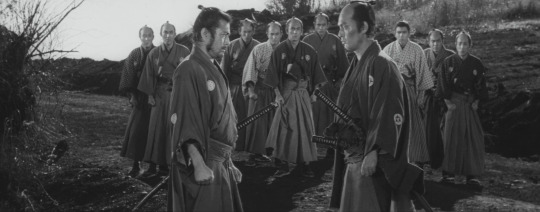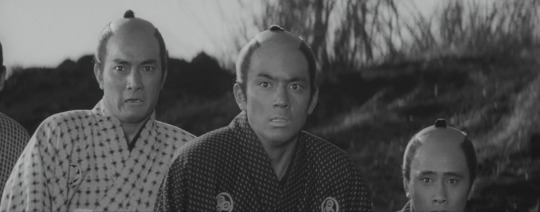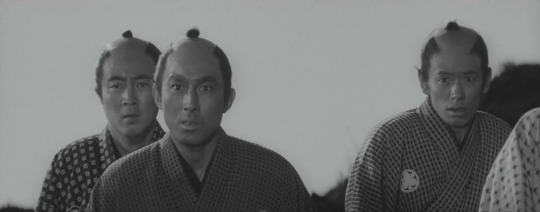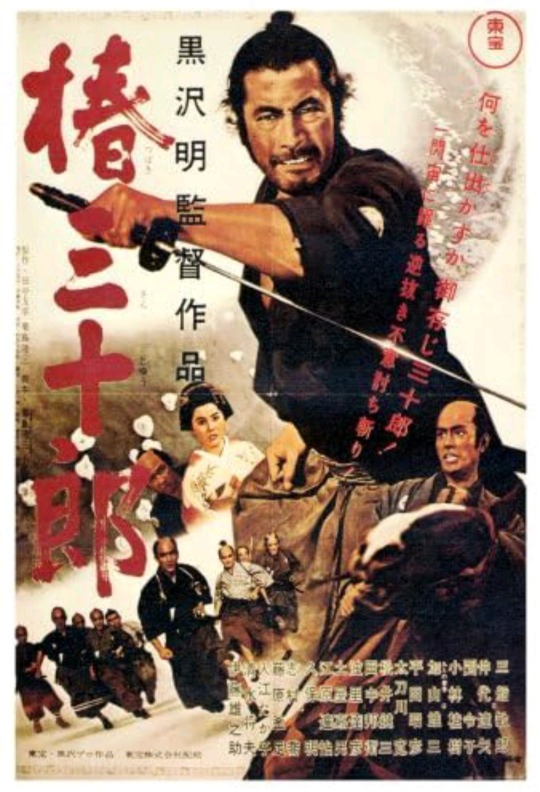#tsubaki sanjuro
Explore tagged Tumblr posts
Text









character requests wrap up
thank you all these were so much fun!
#i wanted the styles to be more uniform but there they be#for the character requests#my art#halo#master chief#pablo schreiber#golden kamuy#rikimatsu ariko#ipopte#the crow#eric draven#disa#dragon's dogma 2#cirilla of cintra#the witcher#devil may cry#dmc#gloria#fortune#mgs#metal gear solid#mifune toshiro#tsubaki sanjuro#john seed#far cry 5#fc5#ciri
271 notes
·
View notes
Text
The Duel









Sanjuro (1962)
Akira Kurosawa
#sanjuro#akira kurosawa#toshiro mifune#samurai#ronin#sanjuro tsubaki#tsubaki sanjuro#samurai cinema#jidaigeki
16 notes
·
View notes
Text

SANJURO (1962). Directed by Akira Kurosawa.
#Sanjuro#Sanjuro Tsubaki#Toshiro Mifune#Hanbei Muroto#Tatsuya Nakadai#samurai#ronin#chambara#jidaigeki#Akira Kurosawa
27 notes
·
View notes
Text

BEHIND-THE-SCENES FROM THE GOLDEN AGE OF JAPANESE CINEMA -- LUNCH-TIME ON THE SET.
PIC INFO: Spotlight on classic Japanese actors Toshiro Mifune (who played the title actor) and Yuzo Kayama (samurai youth Iori Izaka), enjoying their meal on the set of "Sanjuro" (1962), co-written & directed by Akira Kurosawa.
Source: https://x.com/mutokuten/status/1428768677323739147.
#Sanjuro#Sanjuro 1962#Sixties#1962#1960s#Sanjuro 1962 Movie#椿三十郎#Japanese Film#Akira Kurosawa#Toshiro Mifune#Cinema#Japanese Movies#Behind-the-Scenes#Japan#60s Cinema#Golden Age of Japanese Cinema#Yojimbo 1961#Photography#Vintage Style#Lunch Time#Jidaigeki Cinema#Vintage fashion#Japanese Style#Jidaigeki#Tsubaki Sanjūrō#Japanese Cinema#60s Movies#Jidaigeki Movies#Jidaigeki Films#Tsubaki Sanjūrō 1962
18 notes
·
View notes
Text


i <3 tsubakis dad. he doesn't appear for very long but the 10 panels he's in are great. mwah
#sanjuro nakatsukasa#soul eater#tsubaki nakatsukasa#soul eater oc#tsubakis dad#man i love this guy#hes so divorced and so babygirl and hes such a sweetheart from what we know#him having to use my oc in weapon form is smth ive been rotating periodically#:D
8 notes
·
View notes
Photo


Tsubaki Sanjûrô, Akira Kurosawa, 1962
35 notes
·
View notes
Text

So the guy from Yojimbo (and also Sanjuro) is gonna become a foxgirl, got it.
I'm just farming karma by doing good deeds so when I eat it in 60 years or get stabbed for being snarky in public I can respawn as a foxgirl
#yeah I know he says he’s called Tsubaki Sanjuro in Sanjuro#but that’s him literally looking at a grove of camellia trees and going#yes my name is thirty year old camellia tree#which. tbh very fair and based#also yes as a lawyer this is correct
17K notes
·
View notes
Text

蔓日日草[Tsurunichinichisō] Vinca major
蔓[Tsuru] : Vine, creeping plant
日日[Nichinichi] : Day by day; every day; daily
草[Sō] : Grass, herb
When I was passing through a dreary village, many these vines were crawling out of the yard of a house that has been uninhabited for several years, and some of them were beginning to produce some flowers under the drizzle that had just started to fall. It is a naturalized plant native to Europe, not only the flowers but also the leaves are suitable for appreciation, but is highly fertile and will spread if left unchecked. When the weather warms up a little more, they will produce much more flowers in the place that no one will ever see.
Incidentally, 黒澤明[Kurosawa Akira]'s film Sanjuro(椿三十郎[Tsubaki Sanjūrō]) was based on the story 日日平安[Nichinichi heian](Everyday in peace) by 山本周五郎[Yamamoto Shūgorō]. This story has recently entered the public domain. https://www.aozora.gr.jp/cards/001869/files/57728_75665.html (ja) https://www.youtube.com/watch?v=Uq_rSsbhQnE
79 notes
·
View notes
Text
Sanjuro (1962) Mifune Toshirō as Tsubaki Sanjuro
#your warrior character may have drip but never like toshiro mifune being the ronin eating a rice ball while samurai scamper about#sanjuro#akira kurosawa#film#toshiro mifune
7 notes
·
View notes
Text

A look back at the previous post.
Most of the sixty films of the Kurosawa-Mifune tandem are considered film classics. Some of the most famous ones are Rashomon, Seven Samurai, Hidden Fortress, Throne of Blood, Yojimbo, and Sanjuro. Mifune played a samurai in them. Believe it or not, Mifune is the first to admit that he is only a student of kendo. Even so, many great masters of Japanese swordsmanship said that Mifune's handling of the Japanese katana was perfectly demonstrated in the film.
In Japan, it is possible to return to the world of the samurai by visiting any old city such as Kamakura, Kyoto or Nara. Toshiro Mifune is known throughout the world for many such roles, dedicated to some of the famous ronin - or masterless samurai.
During the filming of Tsubaki Sanjuro, Kurosawa's story about the exciting life of ronin during the early Tokugawa period, Mifune became acquainted with the ancient kendo school of swordsmanship, "Kotoh Eiri-Ryu". The name of the school means "Wonderful sword flickers in the darkness of the shadows". Mifune's sporting blood fueled the story, which is, of course, legendary. During feudal times, a swordsman from this school could take out more than eight people in just five seconds.
28 notes
·
View notes
Text

Tsubaki Sanjûrô
Sanjuro
JP, 1962
Akira Kurosawa
8/10
Yojimbo, parte II
Menos conhecido do que Yojimbo, estreado no ano anterior, este Sanjuro é, na verdade, uma sequela do primeiro, ainda que com personagens diferentes, mas com os mesmos atores principais, Toshiro Mifune, no papel do ronin invencível, e Tatsuya Nakadai, no papel do vilão.
O sucesso de Yojimbo levou a Toho a pedir a Kurosawa uma sequela. Ele pegou então num projeto anterior, que pretendia ser uma adaptação fiel da novela "Peaceful Days" de Shûgorô Yamamoto, e transformou-o neste Tsubaki Sanjûrô, reutilizando o tema musical, personagens e principais atores de Yojimbo.
Curiosamente, o mesmo que Sergio Leone fez com o sucesso de "Por um Punhado de Dólares", remake de Yojimbo, e "Por Mais Alguns Dólares", sequela de argumento original, que apenas aproveita um personagem, o ambiente e o ator principal do filme anterior.
Sanjuro é um bom filme de samurais, ao melhor estilo de Kurosawa e Mifune, mas não é Yojimbo. É divertido, tem muita ação, tem até o que alguns dizem ser a primeira cena de explosão de sangue num duelo, no que viria a ser uma imagem de marca do género, copiada por Tarantino, mas falta-lhe o carisma da prequela. Há um lado de farsa que corrói o dramatismo de Yojimbo, mesmo com o duelo final ao pôr do sol, como nos filmes de cowboys.
Ainda assim, é altamente recomendado para os apreciadores do género.
Yojimbo, part II
Less known than Yojimbo, released the previous year, this Sanjuro is, in fact, a sequel to the first, albeit with different characters, but with the same main actors, Toshiro Mifune, in the role of the invincible ronin, and Tatsuya Nakadai, in the role of the villain.
Yojimbo's success led Toho to ask Kurosawa for a sequel. He then took a previous project, which was intended to be a faithful adaptation of Shûgorô Yamamoto's novel "Peaceful Days", and transformed it into this Tsubaki Sanjûrô, reusing the musical theme, characters and main actors from Yojimbo.
Interestingly, the same thing that Sergio Leone did with the success of "For a Fistful of Dollars", a remake of Yojimbo, and "For a Few Dollars More", a sequel with an original script, which only takes advantage of one character, the theme and the main actor of the previous film.
Sanjuro is a good samurai film, in the best style of Kurosawa and Mifune, but it is not Yojimbo. It's fun, there's a lot of action, it even has what some say is the first blood explosion scene in a duel, in what would become a hallmark of the genre, copied by Tarantino, but it lacks the charisma of the prequel. There is a side of farce that corrodes the drama of Yojimbo, even with the final duel at sunset, like in cowboy films.
Still, it is highly recommended for lovers of the genre.
2 notes
·
View notes
Text


Character requests 8/9
snjro.jpeg
#nearing the end#legend#tsubaki sanjuro#for theashenphoenix 🤍#mifune toshiro#sanjuro#yojimbo#kuwabatake sanjuro#kurosawa akira#my art#for the character requests
68 notes
·
View notes
Text
Assistir Filme Sanjuro Online fácil
Assistir Filme Sanjuro Online Fácil é só aqui: https://filmesonlinefacil.com/filme/sanjuro/
Sanjuro - Filmes Online Fácil

No Japão por volta do século XVIII, nove jovens decidem apresentar uma acusação de corrupção em seu clã ao superintendente local. No entanto, o grupo é traído, mas o ronin Sanjûrô Tsubaki (Toshirô Mifune), um samurai desalinhado e cínico, os salva dos homens do superintendente. Então o tio do líder dos clãs rebeldes, o Chamberlain Mutsuta (Yûnosuke Itô), é seqüestrado e sua esposa e filha são detidas e feitas prisioneiras do superintendente que tenta forçar Mutsuta a escrever uma falsa carta de confissão declarando ser corrupto. Sanjûrô ajuda o grupo a resgatar o Chamberlain e sua família.
0 notes
Text

Akira Kurosawa
1961
2 notes
·
View notes
Photo


椿三十郎 (Tsubaki Sanjūrō) - 黒澤 明 (Kurosawa Akira) - 1962
18 notes
·
View notes